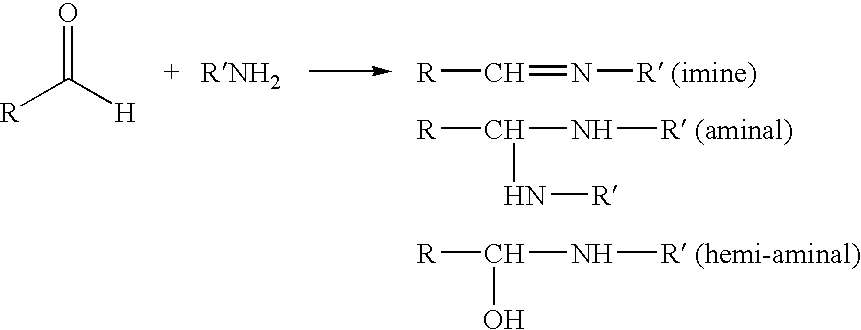Process for bonding chemical additives on to substrates containing cellulosic materials and products thereof
a cellulosic material and chemical additive technology, applied in the field of paper product manufacturing, can solve the problems of chemical additives simply not bonding well with the cellulosic materials, humectants and softeners, and problems experienced
- Summary
- Abstract
- Description
- Claims
- Application Information
AI Technical Summary
Problems solved by technology
Method used
Image
Examples
example 1
[0089]In this particular example, dialdehyde cellulose was prepared by treating cellulose with periodate as known in the art. The pulp was oxidized by the periodate treatment, and reactive aldehyde groups developed on the surface. Next, the polysaccharide was made into a slurry with a consistency of about 2-3%. Then, an amine, such as an aminated polypropylene glycol, like Jeffamines® produced by Huntsman Chemical Inc, was added to the slurry in approximately a 2 to 8 fold molar excess of amine to aldehyde to convert as many aldehyde groups as possible.
[0090]The slurry was given the appropriate time, depending on the amine used and the experimental conditions, anywhere from about 30 minutes to about 12 hours, to react. Finally, the reacted slurry was washed in water and filtered several times to remove residual unreacted amine.
[0091]The following amines were reacted with aldehyde cellulose:[0092]1. 3-amino-1,2 propane diol[0093]2. Jeffamine M-2070[0094]3. Jeffamine ED-600[0095]4. Di...
example 2
[0101]In this example, aldehyde cellulose, having a copper number of 7.25, was prepared by periodate oxidation method as described above. Next, five-gram samples of the aldehyde cellulose were reacted with various amines at multiple reaction temperature and times. Also, Jeffamine ED-900 was added to a sample at a 1 to 4 molar ratio of amine to aldehyde and tested. Further, diamines were tested.
[0102]Then, about {fraction (1 / 10)} of the fibers were diluted with 500 cc of deionized (DI) water and vacuum filtered on a glass frit Bucchner funnel. The filter sheets were removed from the funnel and placed in a 125° C. oven to dry for 5 minutes. After the samples were washed and dried, they were sent to a commercial laboratory for elemental Nitrogen analysis. The results are shown in the following table:
[0103]
Amine Added To AldehydeReaction% N2% By# Per%CelluloseTimeTempFoundWeightTonSubstitutionJeffamine ED-900120 min50° C.0.3210.920630.12-(2-aminoethoxy) ethanol0.221.653315.3Diethanol am...
PUM
| Property | Measurement | Unit |
|---|---|---|
| time | aaaaa | aaaaa |
| structure | aaaaa | aaaaa |
| chemical | aaaaa | aaaaa |
Abstract
Description
Claims
Application Information
 Login to View More
Login to View More - R&D
- Intellectual Property
- Life Sciences
- Materials
- Tech Scout
- Unparalleled Data Quality
- Higher Quality Content
- 60% Fewer Hallucinations
Browse by: Latest US Patents, China's latest patents, Technical Efficacy Thesaurus, Application Domain, Technology Topic, Popular Technical Reports.
© 2025 PatSnap. All rights reserved.Legal|Privacy policy|Modern Slavery Act Transparency Statement|Sitemap|About US| Contact US: help@patsnap.com



